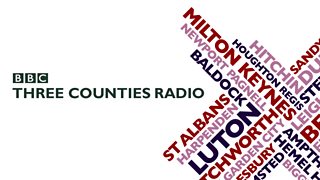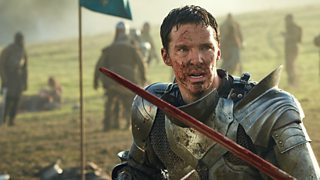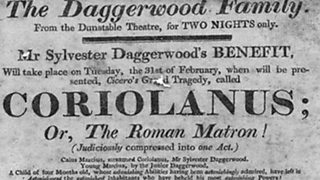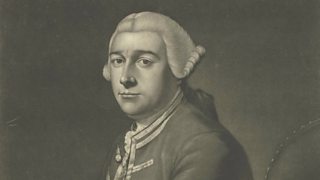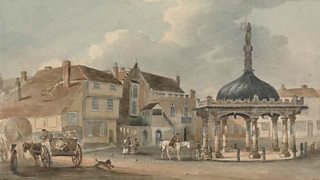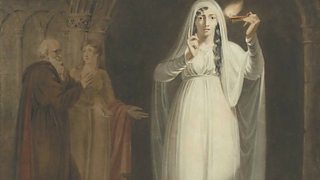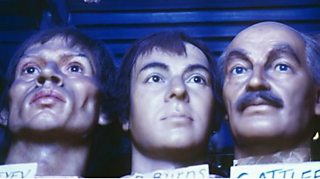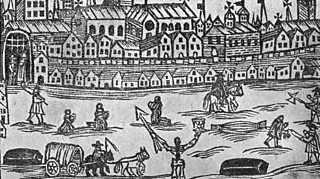Shakespeare's powerful Hertfordshire patron
Shakespeare’s company of actors became known as the Lord Chamberlain’s Men when they gained the patronage of the powerful Henry Carey, 1st Baron Hunsdon (4th March 1526 – 23rd July 1596).
He was an English nobleman, an MP and courtier, and his baronial manor was Hunsdon House, a historic house North-West of Harlow.
-
![]()
Much ado near me
Hear more Shakespeare stories on BBC Three Counties Radio
-
![]()
Shakespeare Festival 2016
The BBC celebrates the genius of the bard
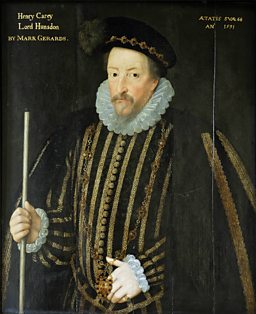
This property was granted to Carey by his cousin, Elizabeth I, in 1559.
As the son of Mary Boleyn, who had been one of King Henry VIII’s mistresses, some whispered that he may have been the illegitimate offspring of the King
His impeccable royal connections meant that Carey himself gained from patronage and, as was the way of the Elizabethan world, was expected to offer patronage to others of a lower socio-economic status.
As the son of Mary Boleyn, who had been one of King Henry VIII’s mistresses, some whispered that he may have been the illegitimate offspring of the King.
Putting such speculation to one side, we know that Carey took over patronage of the key players in Lord Strange’s company when their patron died suddenly in 1594, as well as others from Lord Pembroke’s Men, including the acclaimed actor Richard Burbage and William Shakespeare.
They were one of the two major acting companies who came to dominate the London scene in 1594 and there was fierce rivalry between the LCM and their contemporaries, the Lord Admiral’s Men, although they weren’t the only two active companies.

After Carey's death in 1596, the company came under the patronage of his son, George Carey, 2nd Baron Hunsdon, and for a brief period the players took on the name of their patron, a reminder of his Hertfordshire connection, when they were known as Lord Hunsdon's Men.
By 1600, they had emerged as the leading theatrical company in London and in 1603, became the King's Men under a royal patent from James I
When George Carey became Lord Chamberlain on 17 March 1597, the company reverted to its previous name.
The Lord Chamberlain’s Men performed at the Theatre and the Curtain; in 1599 they moved to the newly built Globe, South of the river, a short walk from the site of the reconstructed Globe we know today. By 1600 they had emerged as the leading theatrical company in London, and in 1603 became the King's Men under a royal patent from James I.
The company continued successfully until the closing of the theatres in 1642.
The Careys’ Hunsdon House has been rebuilt several times, and although it is no longer as it was in the Tudor era, it is a listed building and includes some of the original 15th century brickwork.
Shakespeare on Tour
From the moment they were written through to the present day, Shakespeare’s plays have continued to enthral and inspire audiences. They’ve been performed in venues big and small – including inns, private houses and emerging provincial theatres.

BBC English Regions is building a digital picture which tracks some of the many iconic moments across the country as we follow the ‘explosion’ in the performance of The Bard’s plays, from his own lifetime to recent times.
Drawing on fascinating new research from Records of Early English Drama (REED), plus the British Library's extensive collection of playbills, as well as expertise from De Montfort University and the Arts and Humanities Research Council, Shakespeare on Tour is a unique timeline of iconic moments of those performances, starting with his own troupe of actors, to highlights from more recent times. Listen out for stories on Shakespeare’s legacy on your BBC Local Radio station from Monday 21 March, 2016.
You never know - you might find evidence of Shakespeare’s footsteps close to home…
Craig Henderson, BBC English Regions
Who were the Lord Chamberlain’s Men?
Sally-Beth MacLean, General Editor of Records of Early English Drama, writes:
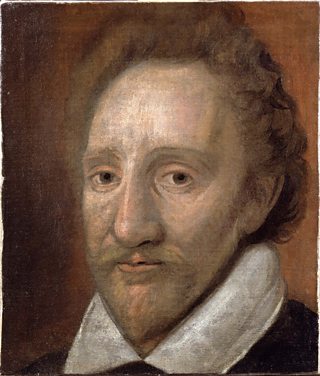
When the Chamberlains' Men was first formed in late spring of 1594, it is very likely that Shakespeare was indeed one of their actors, as well as a contributing playwright, possibly recruited from the remnants of Pembroke's Men, a company known to have hit hard times the previous year.
The Lord Chamberlain's Men was a company of actors for whom Shakespeare wrote most of his acting and writing career.
They kept this name under the reign of Elizabeth I, until James I came to the throne in 1603 when he renamed them 'The King’s Men' under official royal patent. Actor Richard Burbage took the lead roles, including Hamlet and Othello and – later under the King’s Men - King Lear and Macbeth.
The main members formed a core of eight 'sharers' who split both the profits and debts. As well as Burbage and Shakespeare, they also included William Kempe - who took the part of the company’s clown – plus young actors Henry Condell and John Heminges, most famous today for collecting and editing Shakespeare’s plays as the First Folio in 1623.
Related Links
-
![]()
Shakespeare Lives
The nation’s greatest performing arts institutions mark 400 years since the Bard's death
Shakespeare on Tour: Around the Three Counties
-
![]()
Dunstable's theatre poster parody
An example of 18th century style satire
-
![]()
Shakespeare rewritten in St. Albans
David Garrick rewrites Shakespeare for St. Albans
Shakespeare on Tour: Around the country
-
![]()
Ipswich: a magnet for Shakespeare?
Why did Shakespeare's company visit Ipswich ten times?
-
![]()
Sarah Siddons visits Norwich
Putting the Theatre Royal, Norwich, on the map
-
![]()
Madame Tussaud's exhibiton in Nottingham
Including a model of William Shakespeare
-
![]()
Touring Kent to avoid the plague
In 1592, the plague forced touring theatre companies out of London
